In the hustle and bustle of modern life, it can be easy to forget important tasks or let essential daily routines slide. One solution to this problem is the daily checklist. This tool, simple yet powerful, can transform your day, making you more organized, efficient, and productive. In this article, we will discuss everything about a daily checklist and show you how to customize one based on your situation. Let’s get started!
What Is a Daily Checklist
A daily checklist is a list of tasks or actions that need to be completed in a day. It can range from basic activities like eating breakfast and brushing your teeth, to more specific tasks like meeting a work deadline or doing a workout. The idea is to list all the things you need or want to accomplish in a day and then check them off as you complete them.
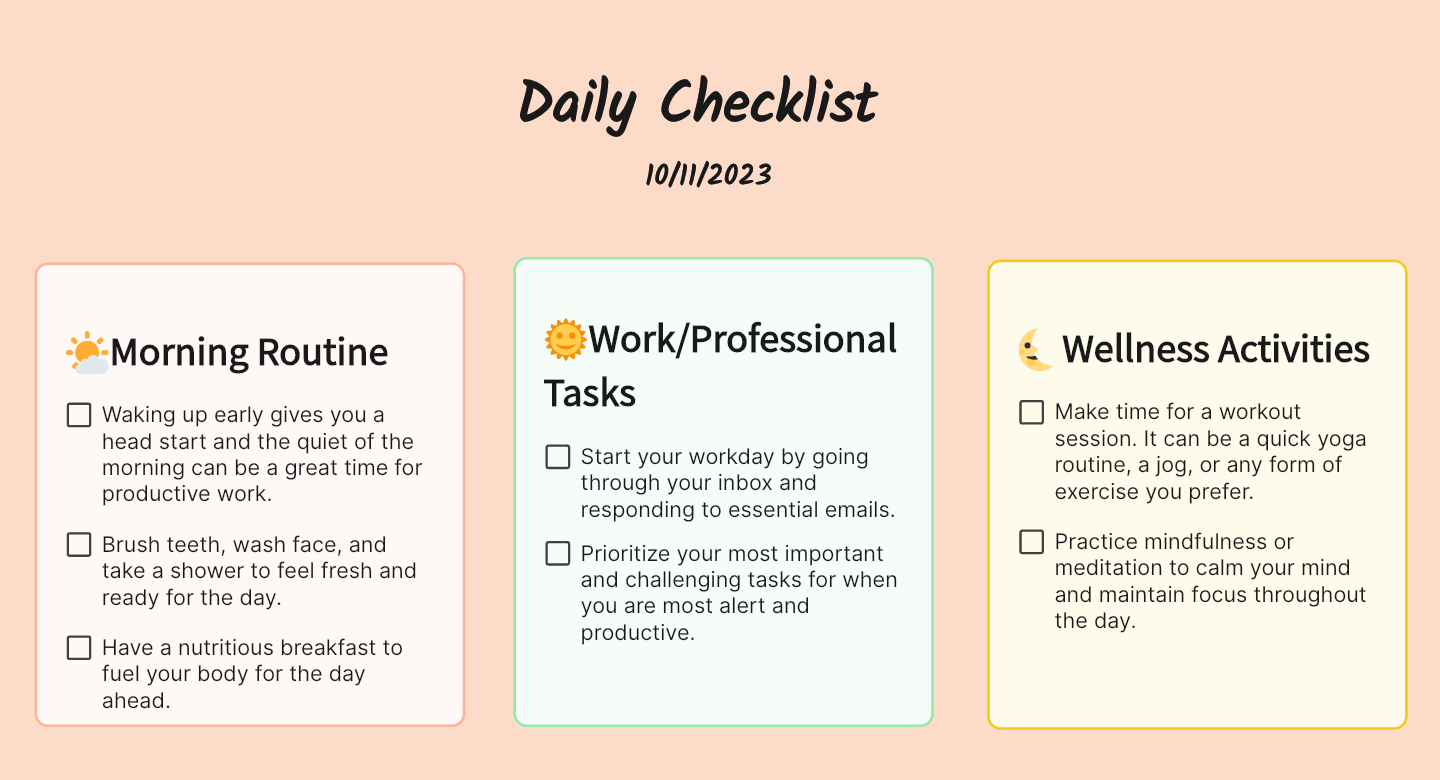
Benefits of an Everyday Checklist
Using an everyday checklist can offer several benefits, enhancing productivity, organization, and overall well-being. Here are some key advantages:
- Organization: Checklists provide a structured way to organize tasks, helping you prioritize and allocate time effectively. This can prevent feeling overwhelmed by a long to-do list.
- Productivity: Breaking down larger tasks into smaller, manageable items on a checklist can make them less daunting. This, in turn, can boost productivity as you focus on completing one task at a time.
- Prioritization: Checklists assist in setting priorities. You can identify and tackle high-priority items first, ensuring that crucial tasks are addressed before less critical ones.
- Motivation: Checking items off a checklist provides a sense of accomplishment. This small win can boost motivation and create positive momentum to tackle more tasks.
- Time Management: Checklists help in managing time more efficiently by providing a clear overview of what needs to be done. This prevents procrastination and aids in meeting deadlines.
- Reduced Stress: Knowing exactly what needs to be done and having a plan can reduce stress. Checklists contribute to a sense of control and order, minimizing the anxiety associated with forgetting or missing important tasks.
- Goal Tracking: Checklists are valuable for tracking progress toward short-term and long-term goals. Regularly reviewing and updating your checklist keeps you on track and aligned with your objectives.
- Improved Focus: With a checklist, you can maintain focus on the current task without constantly worrying about what comes next. This helps improve concentration and the quality of your work.
- Memory Aid: Checklists serve as external memory aids, reducing the mental load of trying to remember all tasks. This is especially helpful for individuals with busy schedules or those managing multiple responsibilities.
- Adaptability: Checklists can be easily adjusted and adapted to changing circumstances. If new tasks arise or priorities shift, you can update your checklist accordingly.
- Communication: In team settings, checklists can be shared to enhance communication. They provide clarity on individual responsibilities and contribute to collaborative efforts.
- Reflection: Reviewing completed checklists allows for reflection on achievements and areas for improvement. This reflective practice can contribute to personal and professional development.
Incorporating a daily checklist into your routine can be a simple yet effective strategy for enhancing productivity and maintaining a sense of control over your tasks and responsibilities.
What Should Be on Your Daily Checklist
The contents of your daily checklist will largely depend on your personal circumstances and lifestyle. However, here are some common elements that many people find useful:
- Health & Self-Care: Tasks like eating healthy meals, exercising, drinking plenty of water, and getting sufficient sleep are important for maintaining physical and mental wellbeing.
- Work Tasks: Your daily work responsibilities, deadlines, and goals should be outlined in your checklist.
- Personal Growth: Include activities that contribute to your personal development, like reading, learning a new skill, or practicing a hobby.
- Family & Relationships: Time spent with loved ones or tasks related to their needs can also be part of your checklist.
- Household Chores: Regular household chores and maintenance tasks should not be forgotten.
Remember, the key to a good daily checklist is customization. Tailor it to suit your lifestyle, priorities, and goals. Over time, you’ll see how this simple tool can have profound effects on your productivity and peace of mind.
Crafting a daily routine checklist can be a game-changer for your productivity and organization. It provides a structured approach to manage your day-to-day activities, thereby boosting efficiency and reducing stress. Here's a detailed example of a daily routine checklist that covers various aspects of a typical day.
A Detailed Daily Routine Checklist Example
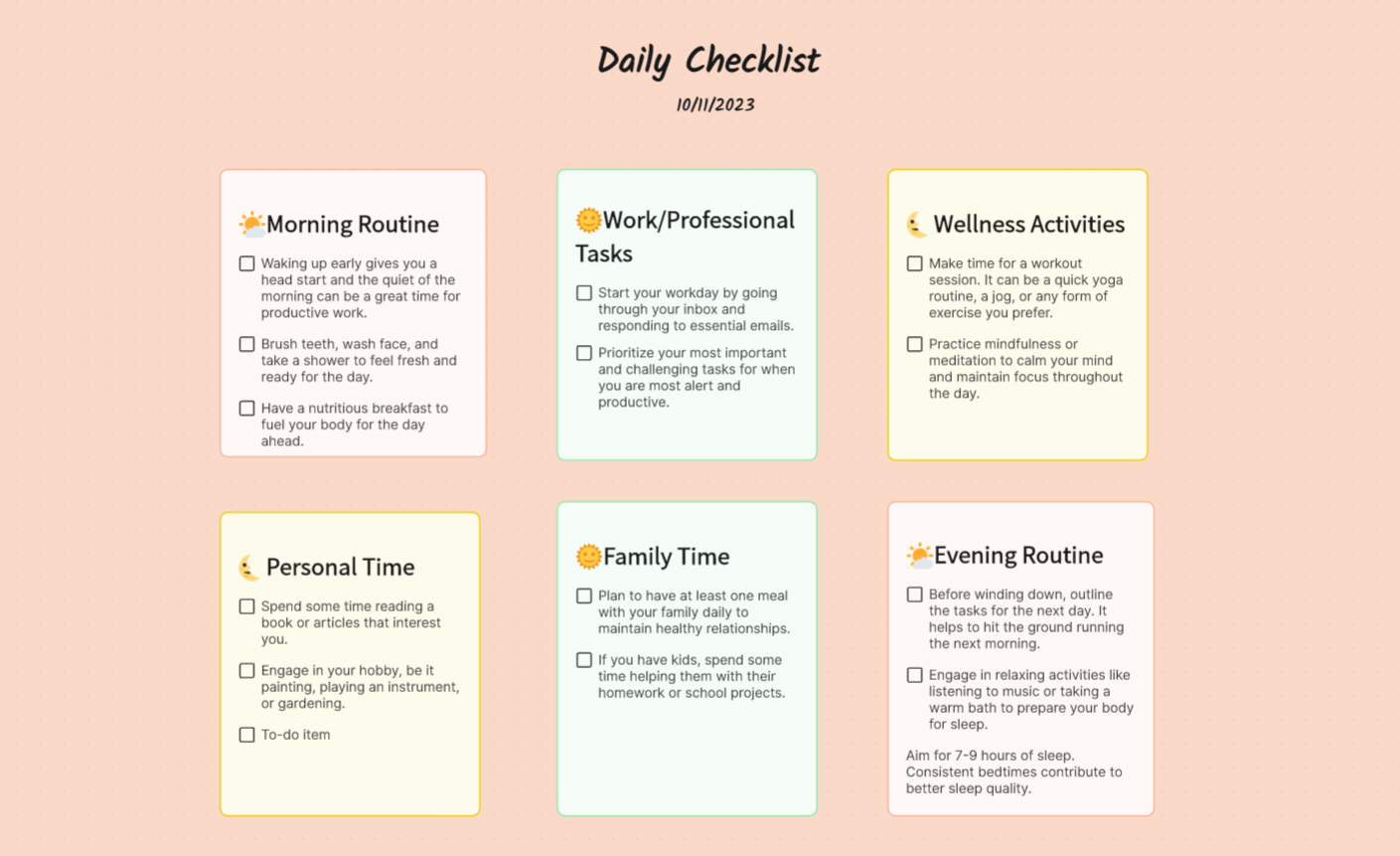
Morning Routine
- Waking up early gives you a head start and the quiet of the morning can be a great time for productive work.
- Brush teeth, wash face, and take a shower to feel fresh and ready for the day.
- Have a nutritious breakfast to fuel your body for the day ahead.
Work/Professional Tasks
- Start your workday by going through your inbox and responding to essential emails.
- Prioritize your most important and challenging tasks for when you are most alert and productive.
Wellness Activities
- Exercise: Make time for a workout session. It can be a quick yoga routine, a jog, or any form of exercise you prefer.
- Mindfulness: Practice mindfulness or meditation to calm your mind and maintain focus throughout the day.
Personal Time
- Spend some time reading a book or articles that interest you.
- Engage in your hobby, be it painting, playing an instrument, or gardening.
Family Time
- Plan to have at least one meal with your family daily to maintain healthy relationships.
- If you have kids, spend some time helping them with their homework or school projects.
Evening Routine
- Before winding down, outline the tasks for the next day. It helps to hit the ground running the next morning.
- Engage in relaxing activities like listening to music or taking a warm bath to prepare your body for sleep.
- Aim for 7-9 hours of sleep. Consistent bedtimes contribute to better sleep quality.
Remember, this is just an example. Everyone’s daily routine varies based on their lifestyle, work commitments, personal preferences, and health needs. Feel free to tweak this checklist as needed to create one that works best for you.
How to Make a Daily Checklist Using Boardmix
Boardmix is an online task management tool that offers various features, one of which is creating checklists. It helps users stay organized, prioritizes tasks, and tracks their progress efficiently. This part will provide you with step-by-step instructions on how to make a daily checklist mentioned above using Boardmix.

Step 1: Log in or Sign Up
The first step is to log into your Boardmix account. If you don't have one, navigate to the Boardmix website and click on the 'Sign up' button. Follow the prompts to create a new account.

Step 2: Create a New Board
Once logged in, click on the 'New board' button usually located on the dashboard's top left side. Enter a name for the board; for this guide, we'll call it "Daily Checklist."

Step 3: Add a Template to Your Board
You can go to the Boardmix template center for different checklist templates. For a daily checklist, you can use the “Daily To-do List” one.
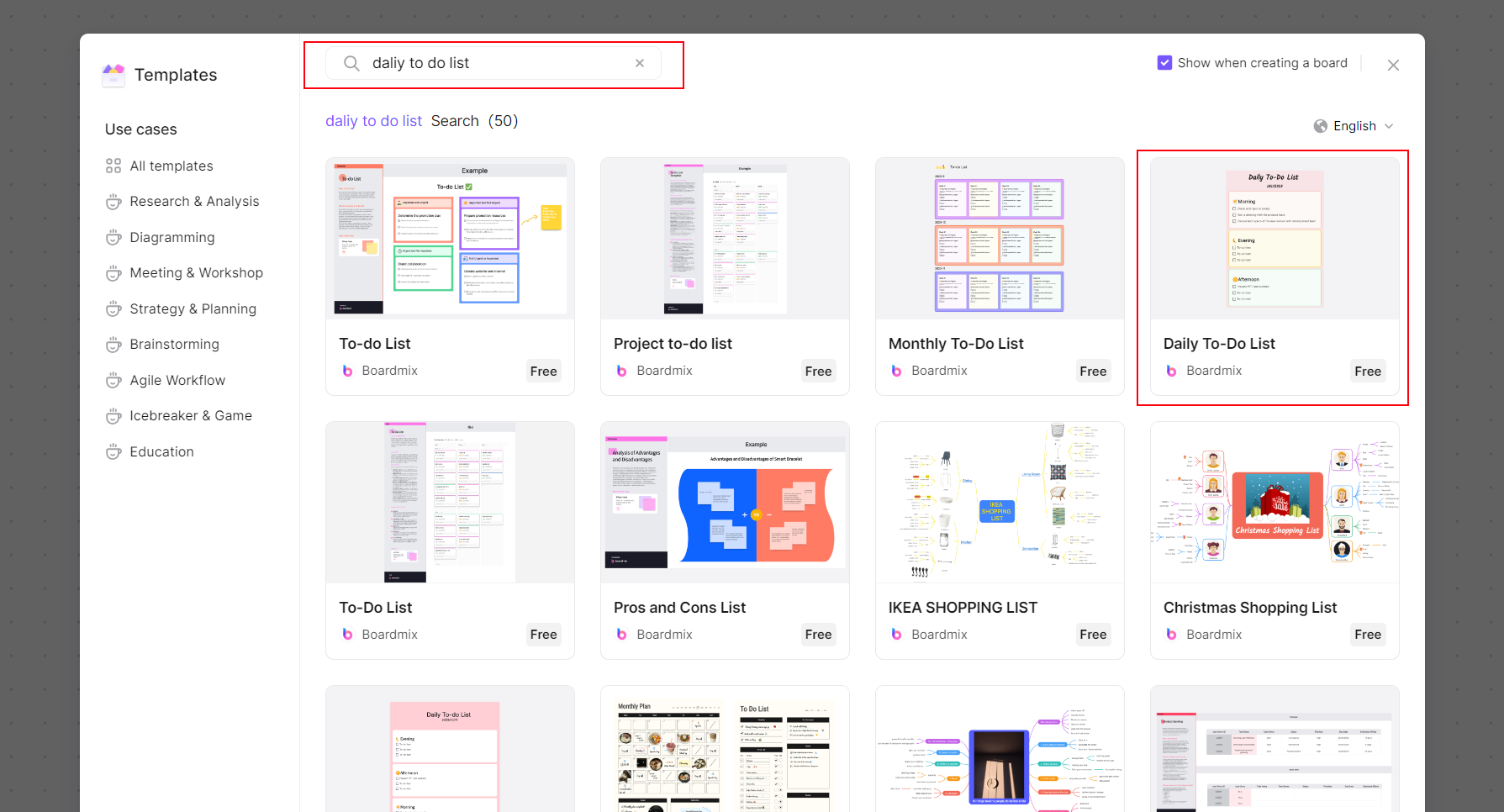
Step 4. Name and Add Lists
Each card in the template consists of multiple lists that can represent different categories. For example, your daily checklist could include lists such as 'Morning Routine,' 'Work/Professional Tasks,' 'Wellness Activities,' 'Evening Routine.' To create a list, click on the '+' button next to your last list (or in the space where the first list should go). Enter the list title and press enter.
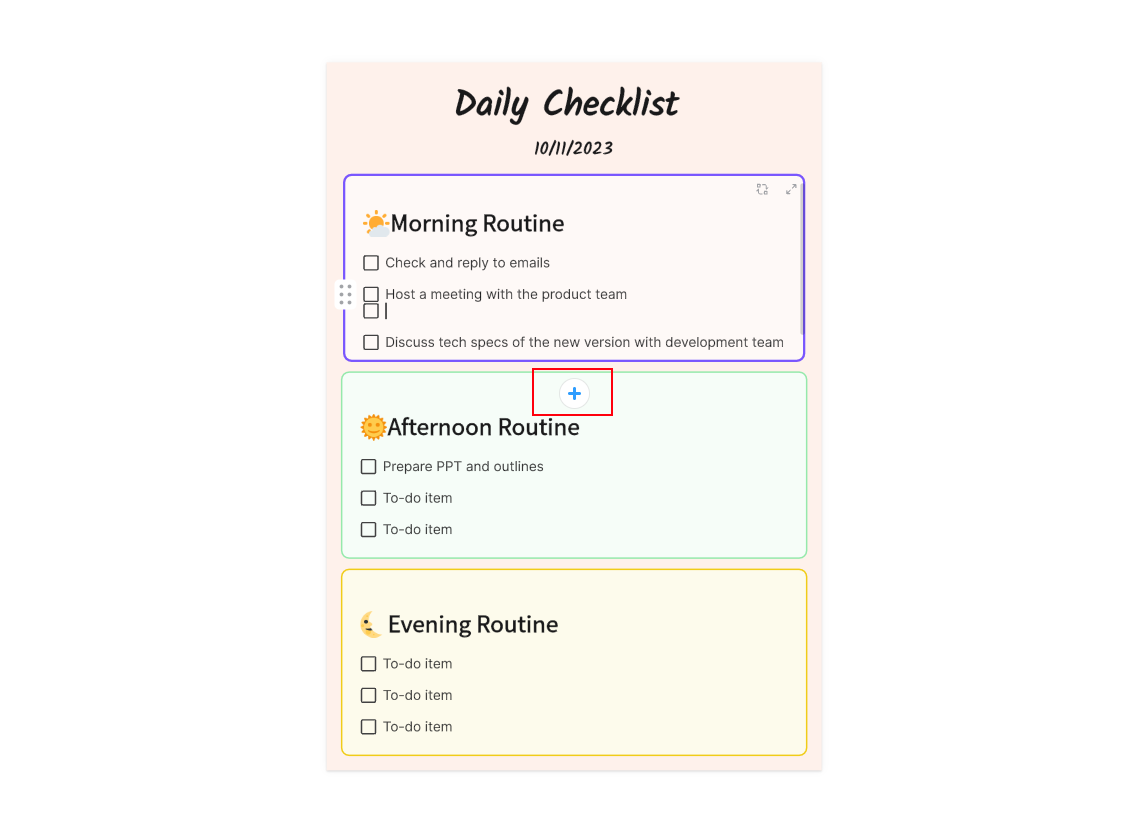
Step 5: Add Tasks (Checklist Items) to Your Lists
Now, you'll add individual tasks to each of your lists. Press the Enter key to create more tasks. Repeat this process for all tasks you want to include in your daily checklist.
Step 6: Add Details to Your Tasks
Boardmix allows you to add more details to your tasks. You can set due dates, add labels for prioritization, insert comments for additional information, or even attach files related to the task.
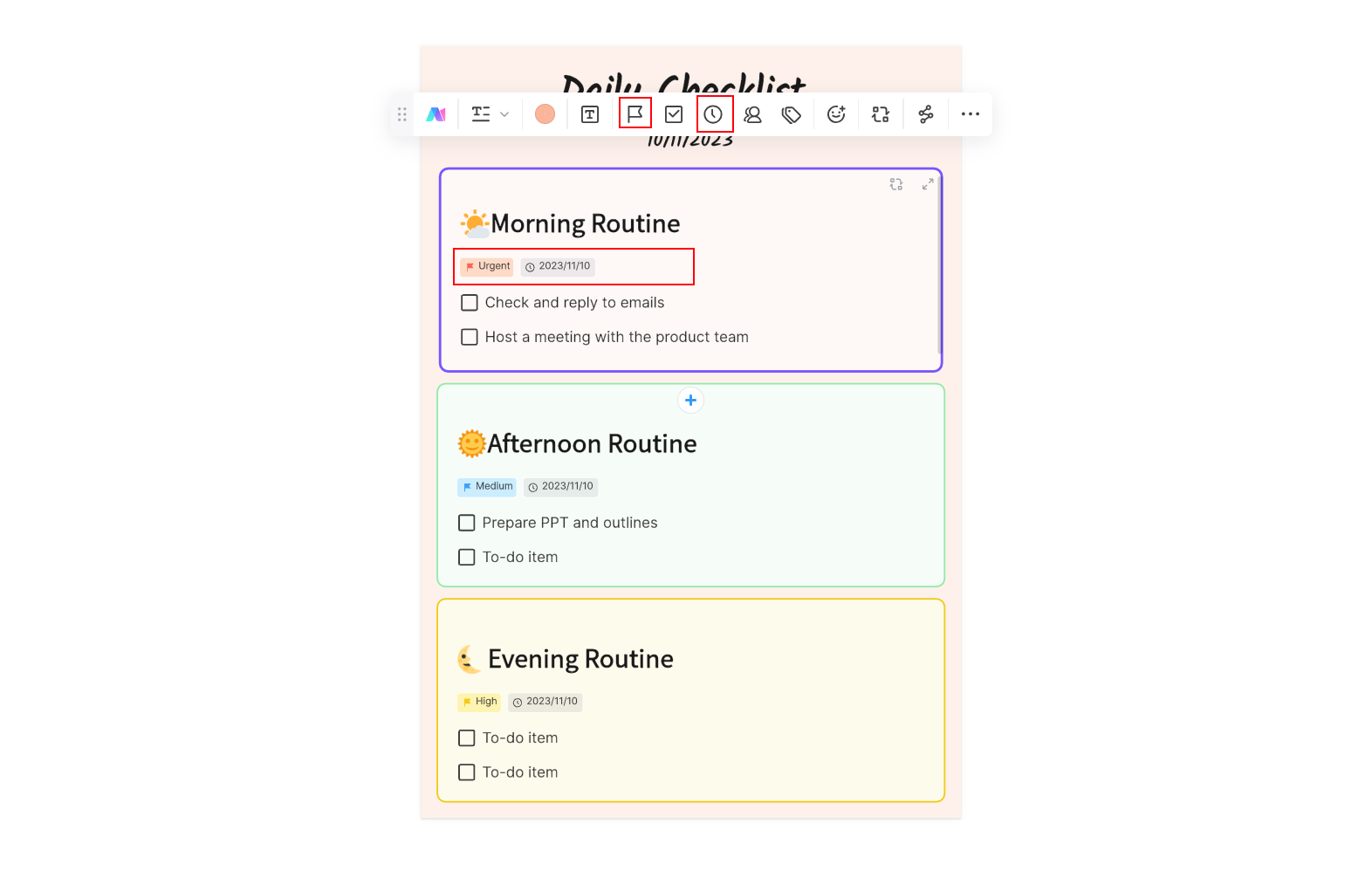
Step 7: Review and Update Your Checklist
As you complete tasks throughout the day, you can check them off by clicking on the checkbox in front of each task. At the end of the day or the beginning of a new day, review your checklist. Move any incomplete tasks to the next day's list or delete tasks that are no longer relevant.
Creating a daily checklist using Boardmix is an excellent way to stay organized and improve productivity. This easy-to-use tool ensures that you never lose track of important tasks and provides you with an organized framework for managing your day effectively.
Tips and Tricks on Making Your Everyday Checklist
An everyday checklist is a fantastic tool for managing tasks, increasing productivity, and improving organization. Whether it's for personal use or professional purposes, an efficient checklist can make all the difference. Here we're offering useful tips and tricks for creating an effective everyday checklist.
- Keep It Simple: The best checklists are those that are easy to understand and follow. Avoid over-complicating things by including too many details. Focus on the key tasks and activities that need to be done.
- Prioritize Your Tasks: Not all tasks are created equal. Some are more urgent or important than others. Arrange your tasks in order of priority to ensure the most critical tasks get done first.
- Be Realistic: While it might be tempting to fill your checklist with numerous tasks, it's essential to be realistic about what you can accomplish in a day. Overloading your checklist can lead to stress and the feeling of being overwhelmed.
- Use Categories: Organize your tasks into categories. This could be based on the nature of the tasks (work, personal, health), or the time of day (morning, afternoon, evening). Categories help break down your list into manageable parts and can make it easier to navigate your checklist.
- Check Off Tasks As You Go: As you complete each task, check it off or cross it out. This gives you a sense of achievement and motivates you to tackle the next task.
- Review and Revise Regularly: Your everyday checklist should not be static. Review it regularly and make adjustments as needed. Remove tasks that are no longer relevant and add new ones as they come up.
- Use a Checklist App: Consider using a checklist app like Google Tasks, Todoist, or Boardmix. These apps allow you to create, manage, and update your checklists on the go. Most also come with handy features like reminders and notifications.
- Break Down Big Tasks: If a task is too big, break it down into smaller, more manageable subtasks. This prevents feeling overwhelmed and makes tackling large projects easier.
- Keep It Visible: Keep your checklist where you can see it frequently. This could be on your desk, on your fridge, or as a wallpaper on your phone or computer.
- Be Flexible: While a checklist is meant to bring structure to your day, it's important to remain flexible. If something urgent comes up, don't hesitate to rearrange your list.
In conclusion, an everyday checklist is an excellent tool for staying organized and boosting productivity when used effectively. Implement these tips and tricks to make the most out of your daily checklist.









